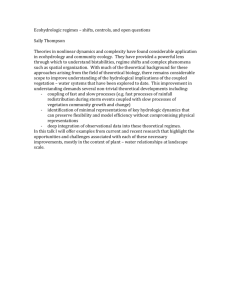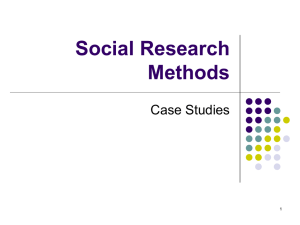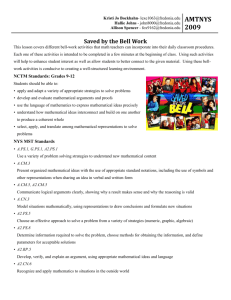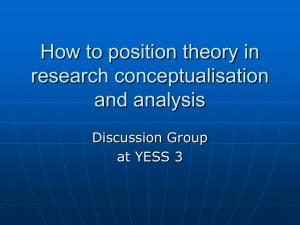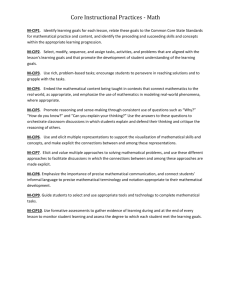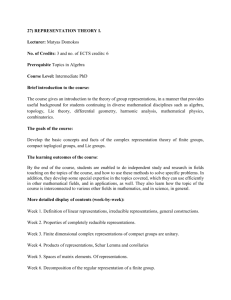Casyopée - Site professionnel de JB Lagrange
advertisement
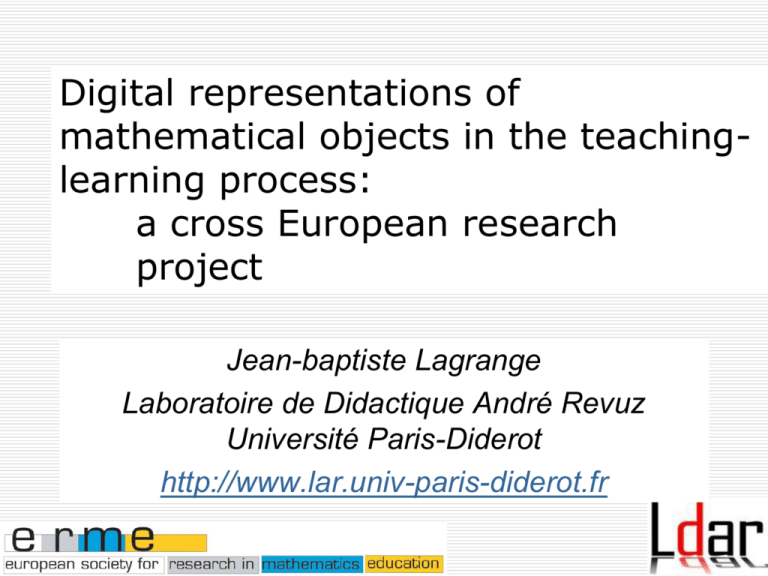
Digital representations of mathematical objects in the teachinglearning process: a cross European research project Jean-baptiste Lagrange Laboratoire de Didactique André Revuz Université Paris-Diderot http://www.lar.univ-paris-diderot.fr The ReMath project Representing Mathematics with digital medias Communication, cooperation and collaboration …for connecting ideas about representations networking theoretical frameworks Plan ReMath: questions and working plan The ReMath’s approach Cross case studies as a methodology The Casyopée cross-case Presentation Small group work Report and Discussion Conclusion on ReMath 35mn 20mn 25mn 10mn Representing Mathematics with Digital Media STREP Number IST4-26751 (FP 6) 42 months (Dec. 2005 - May 2009) Six teams Instituto Technologie Didattiche, ITD Genova Università degli Studi, UNISI Siena National Kapodistrian University, ETL Athens Institute of Education, IOE London Université Joseph Fourier, Mehta Grenoble Université Paris Diderot, Didirem Paris FP6 European research activities are structured around consecutive programmes, or so-called Framework Programmes. 1984: First Framework Programme (1984-1987) 1987:“European Single Act” -science becomes a Community responsibility 1987: SecondFramework Programme (1987-1991) 1990: Third Framework Programme (1990-1994) 1993:Treaty on European Union; role of RTD in the EU enlarged 1994: Fourth Framework Programme (1994-1998) 1998: FifthFramework Programme (1998-2002) 2002: SixthFramework Programme (2002-2006) 2007: Seventh Framework Programme (2007-2013) The Sixth Framework Programme (FP6) 2002-2006. the Priority – Information Society Technologies IST 2005-06 Work Program. strategic objective 2.4.10 “Technologyenhanced learning (TEL)” To explore interactions between the learning of the individual and that of the organisation … To contribute to new understandings of the learning processes by exploring links between human learning, cognition and technologies. Key Objectives 1. To bridge the gap between technology and pedagogy 2. A representations-based approach to cognition in learning mathematics we can only access and operate on Mathematical objects by means of representations. the potential impact of ICT tools on mathematical learning seen through the filter of representations. 3. Support to teachers and learners offering tools that address not only individual cognition but also the entire learning situation 4. Integration of efforts in the European context how different theoretical frameworks deal with the question of representations. Methodology A cyclical process of a) desiging and developing six state-of-theart DYNAMIC DIGITAL ARTEFACTS for representing mathematics, b) developing scenarios for the use of these artefacts for educational added value c) carrying out empirical research involving cross-experimentation in realistic educational contexts The project’s structure WP1 : Theoretical integration WP2 : Software developpement WP3 : Scenarios (pedagogical plans) WP4 : (cross) experimentations WP5 : Multilingual repository and communication platform (Math.Di.L.S.) http://remath.cti.gr D1 Integrated theoretical framework Version A m6 D4 First Version of the Dynamic Digital Artefacts m12 D7 Scenario Design, First Version m15 D8 Release Version of Dynamic Digital Artefacts m18 D9 Integrated theoretical framework Version B m18 D10 Scenario Design, Refined Version m18 D11 Research design m20 D13 Design-Based Research: process and results m30 D16 Refined Version of Dynamic Digital Artefacts m33 D17 Scenario Design, Final Version m36 D18 Integrated theoretical framework Version C m36 DDAs: Digital Didactical Artefacts Diversity in ReMath: DDAs Domains and objects: algebra, functions, 3D geometry, cinematic, geography… Representations connections between them, means of action possibilities of evolution Distance with usual systems of representation, usual software used in education, with the curriculum Initial Diversity : Frameworks ETL Theoretical Integration Progressive elaboration of a shared theoretical basis about representations Extension of the connections between frameworks Specific common research tools Distinction between metaphoric and functional use of theories The language of “concerns” The idea of “didactical functionalities” (1)Tool features, (2) Educational goals, (3) Modalities of employment A special methodology: the cross case studies ETL Didirem UNISI alien familiar Casyopée alien familiar Cruislet alien Casyopée Epistemological Profile Objects represented mathematical function of one variable(families of) dependencies in a physical system (2D geometry) algebraic functions Curriculum compatible but innovative Connections and activities Crossing two entries Three different levels where functions can be represented Two types of representations, with specific activities Casyopée Three different levels where covariation and dependency can be experienced and/or represented. 1. Physical systems (dynamic geometry) 2. Magnitudes and measures 3. Mathematical Functions Casyopée Representations and Types of activities Enactive-iconic Representations (Tall) Experience of movements inside physical systems Work on graphical or tabular representatives issued of physical systems ‘Explorations’ on graphs and tables of mathematical functions Algebraic Representations Semiotic Registers of representations (Duval 1999) Treatments - Conversions Three categories of activities (Kieran 2004) generational transformational global / meta-level Casyopée Representations and Types of activities Enactive-Iconic levels Covariation and dependency in a physical system __________ Covariation and dependency between magnitudes or measures __________ Mathematical Functions of one real variable PME 33 Local Global Small moves. Observin g effect on elements ________ Small moves. Observin g effect on values ________ Tracing graphs Browsing Tables Moving elements Observing transformations ________ Graphs of measure against time or another magnitude ________ Perceiving properties of graphs and tables Algebraic Generational ________ Building prealgebraic “geometrical ” formula. Choosing an independent variable. ___________ Expressing algebraically a domain and a formula Transforma. GlobalMeta Considering ‘generic’ objects and measures. Interpreting ___________ Computing, recognising equivalent expressions. Choosing an appropriate form ___________ Working on ‘families’ of functions Parameters (animated or formal). Proving Casyopée An optimisation problem a, b, c, 3 parameters >0 A(-a,0); B(0,b); C(c,0) Find a rectangle MNPQ of maximal area with M on [OA] ; Q on [OC] ; N on [AB] and P on [BC] Casyopée CONNECTIONS BETWEEN ACTIVITIES Magnitudes Enactive-Iconic Algebraic Generational Moving elements Observing effects on values Building pre-algebraic “geometrical” formula. Casyopée CONNECTIONS BETWEEN ACTIVITIES Algebraic Generational Magnitudes Choosing an independent variable Mathematical Expressing Function algebraically a domain and a formula Casyopée CONNECTIONS BETWEEN ACTIVITIES Enactive-Iconic Physical system Small moves Observing effect on objects Magnitudes or measures Small moves Observing effect on values Mathematical Functions Tracing graphs Browsing Tables Casyopée cross-case study Context in the two experiments A DDA innovative but highly compatible with the curriculum. Close epistemological and didactic references Previous collaboration teachers/researchers Grade levels: Grade 11 (France), Grade 12 (Italy) Institutional pressure: High (France)/Moderate (Italy). Teachers Familiar with DDA: Yes (France)/No (Italy). Casyopée cross-case study DIDIREM and UNISI Theoretical frameworks Theory of Semiotic Mediations Activity Theory Instrumenta l Approach Semiotic Register Background on Functions UNISI Theory of Didactical Situations DIDIREM Anthropo. Theory of Didiactics DIDIREM Theory of didactic situations (TDS) Attention to students’ a-didactic interaction with the milieu of the situation. Careful choice of tasks and control of the didactic variables Anthropological theory of didactics (ATD) Ecological perspective Sensibility to institutional constraints and norms Attention to (instrumented) techniques UNISI Theory of semiotic mediations (TSM) Gives much attention to the collective progression of mathematics knowledge Through the progressive evolution of systems of signs: students’ personal signs first linked to their activity with the artifact shared during collective activities purposefully designed, develop with the help of the teachers into semiotic chains towards mathematical signs. Casyopée cross-case study The DIDIREM scenario The UNISI scenario Casyopée cross-case study Questions: 1. What important similarities and differences between the two scenarios? Hypotheses about factors explaining these. 2. What research outcomes can be expected from a cross-study with regard to: (a) representations (b) theoretical integration (c) role of the context? Casyopée cross-case study Similarities and differences Two scenarios with slightly different educational goals but favouring the same type of tasks: functions approached in terms of co-variation; functions approached as modeling tools for problems arising in geometrical context. Two scenarios giving high importance to the interaction between the different semiotic registers offered by Casyopée. The intertwined influence of differences in grade levels and close epistemological views. Casyopée cross-case study Similarities and differences Two scenarios paying evident attention to the process of instrumental genesis but managing it in different ways in the UNISI scenario, an organization of the instrumentalization process mainly concentrated in the first session; in the DIDIREM scenario, a progressive organization of the instrumentalization process along the whole scenario. The influence of a shared instrumental concern combined with the differences induced by its inscription into two different theoretical frames. Casyopée cross-case study Similarities and differences Casyopée cross-case study Summarizing the cross case study • The Didirem team : several theoretical frames. • Attention to students’ instrumental genesis • Compatibility with institutional demand • Process of learning designed through a careful choice of mathematical tasks, with an adidactical potential • But the teacher's actions and role escapes the PP’s design Maracci M., Cazes C., Vandebrouck F., Mariotti M-A. (2009) Casyopée in the classroom: two different theory-driven pedagogical approaches, Proceedings of CERME 6 • The Unisi team has mainly structured its pedagogical plan according to the Theory of Semiotic Mediation • The teacher plays a crucial role throughout the whole pedagogical plan, especially for • fostering the evolution of students’ personal meanings towards the targeted mathematical meanings • facilitating the students’ consciousness-raising of those mathematical meanings Context Cruislet cross-case analysis DIDIREM difficulties with Cruislet Instrumental sensitivity Controlled design The DIDIREM culture Epistemological concern Cruislet Characteristics Technological distance AAnticipating possible cognitive outcomes Anticipating the potential and limit of adidactic adaptations Curricular distance Implementation of mathematical objects Context Conclusion: Beyond ReMath Different conception of the theoretical work connections based on concrete common practice on “boundary objects” understanding the necessity of theoretical constructs their influence on tool and scenario design Research practices as objects for study understanding the consistency of ‘alien’ choices awareness of the crucial role of context in didactical research, and the need for better conceptualization An inspiration for (young) researchers?
